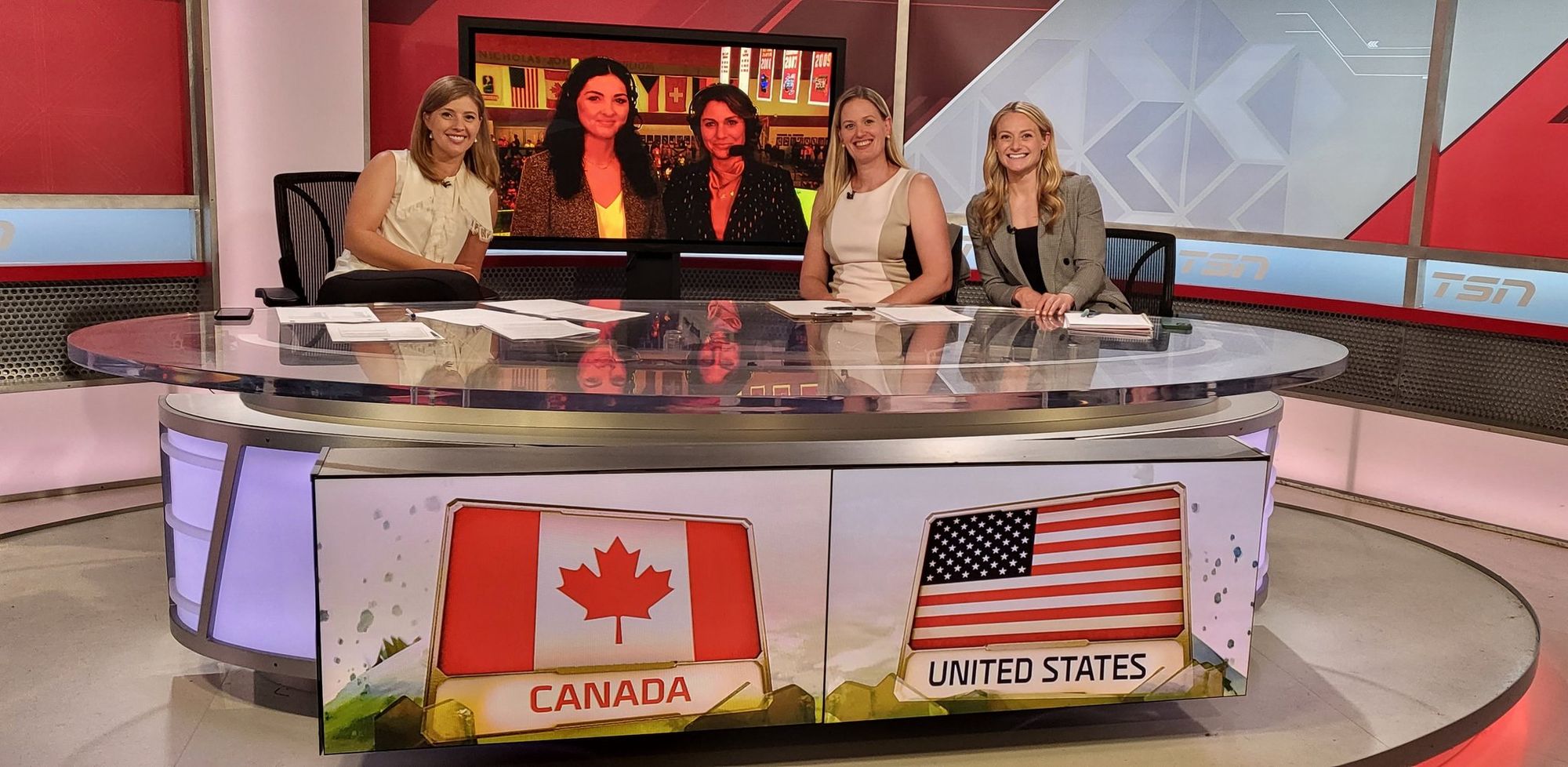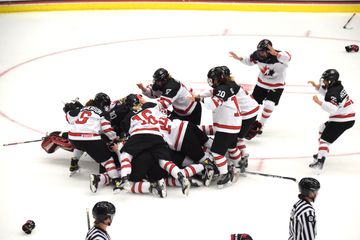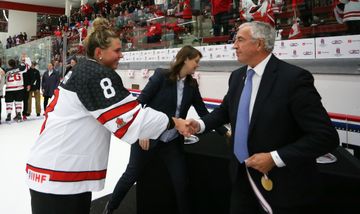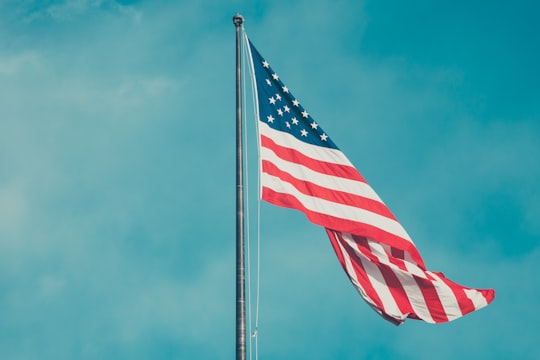For the first time ever, there was broadcast or streaming coverage available of every group stage and playoff game of the IIHF U18 Women's World Championship – at least, if you were in the United States or Canada and had access to both ESPN+ and TSN or NHL Network (plus HockeyTV for those games not on TV). On top of that, there was something different about this broadcast compared to past TSN coverage of international women's hockey tournaments, including the Olympics. A crew comprised entirely of women, many of whom had actual playing experience at the international and professional level, handled the program from start to finish. TSN has regularly looked to Rod Black to provide play-by-play for women's hockey tournaments that it airs as part of its "A crew" (see this post for my thoughts on how he handled a lopsided Canada vs. Germany match at the 2021 IIHF Women's Worlds), but this time, play-by-play commentator Kenzie Lalonde joined color analyst Cheryl Pounder in the booth for every televised game. They were backed up with a studio crew consisting of Renata Fast, Sami Jo Small, and TSN anchor Laura Diakun.
Lalonde had previously made her debut with TSN calling Group B games at the 2021 WWC alongside Carla McLeod and also called PWHPA Secret Dream Gap Tour games for TSN in 2021. She additionally served as a hockey reporter with CBC during the 2022 Olympics. Rod Black parted ways with TSN in October of 2021, which has left the door open for Lalonde's role with TSN to expand in women's hockey coverage. Pounder served as a color analyst alongside Black for many years, but got to showcase more of her knowledge alongside Lalonde's more practical play-by-play style. Fast, Small, and Diakun have all appeared on women's hockey broadcasts before, though Fast has the least on-camera experience among them.
There was a notable change in tone for these U18s. In previous TSN women's hockey broadcasts, Rod Black often spent a lot of time spouting random facts about players – including finding as many opportunities as possible to mention any relatives who had involvement in men's or NHL hockey, as if that was the only way to get the viewers interested. By contrast, Kenzie Lalonde spent her time calmly calling the game itself and left most interjections or factoids to Pounder, who often digressed into detail-oriented X's and O's analysis (catnip for serious hockey fans) and shared her wide knowledge of the women's hockey landscape overall. Intermission reports from the studio crew were a bit more casual (and very excited specifically about Team Canada, for obvious reasons), but still spent a lot of time delving into game tape to get a breakdown from Sami Jo and Renata, and also elaborated on players' histories and development.
"A lot of times, the intermission of games like these or other women's hockey games is mostly just ads — but these panelists broke down what was happening on the ice, and that was really cool to see," said Anne Tokarski, a hockey fan who has previously worked in the sport. "As always, Kenzie Lalonde and Cheryl Pounder also did an amazing job in the booth. Something I noticed in the games I watched was that they focused a lot on the players and their histories, and they KNEW those histories in detail. That level of preparation is something that we don't often see in women's hockey, so it was really nice to feel like I was learning about players from experts. It felt professional and well-done, and honestly really surpassed my expectations. I kind of just expected some standard coverage, but I would say TSN went above and beyond."
Michelle Jay, site manager at the Ice Garden, felt similarly. "I was really impressed by the production value TSN gave us. We rarely, if ever see pre, intermission, and post 'studio shows.' I know they weren't extensive but they were good lead-ins. I think some of the intermission shows had audio issues but honestly that could happen to any show anywhere, so I wasn't as upset about that as I think others were," she said. She also added that the commentary was simply a huge upgrade from what we had previously been subjected to on TSN broadcasts: "I'll listen to Sami Jo Small talk about hockey all day and do kind of wish she was on the call, but I liked Cheryl and Kenzie a lot. In my opinion, because there's so little to Google about these players, they couldn't use that as a crutch and the commentary in-game was stronger because of that. I didn't want to claw my ears out which is obviously a huge step up, nor did I ever want to mute or feel the need to mute. They added rather than subtracted."
Of course, as with any broadcast, your mileage may vary and some of this comes down to both taste and preference. Additionally, there's the matter of bias, something that can be very polarizing among sports fans. Recently, Sean Shapiro and Harman Dyal of The Athletic got fan rankings for each local broadcast in the NHL, and how viewers take "homerism" really seems to depend heavily on matters of style. Spencer Fascetta, who both writes about and conducts statistical analysis of women's hockey, and has broadcasting experience, wasn't a fan of TSN's North American bias. "Understanding that it's a TSN and Hockey Canada broadcast, it was still nauseatingly biased, to the point where they were referencing the US/Canada teams DURING the Sweden/Finland matchups," he said. "The bias really showed itself in the intermission and postgames though. It bothered me that there wasn't a lot of focus on the two Nordic teams in Group A, or even the Group B teams... I would've liked to have seen intermission interviews with Swedish or Finnish or Slovakian or Czech players too during the games they were broadcast. There are players on most rosters who do speak English."
One media professional and broadcaster I spoke to watched the U18 tournament alongside some fathers of current NCAA and OWHA U22 Elite athletes. While this group of viewers felt strongly that the studio crew did great analysis and breakdown, they had other concerns about data accuracy and about TSN's effort to promote the tournament. "There was little hype about the tournament leading up to it, compared to what TSN will do for the WJCs," the broadcaster said. "The commentary seemed to only reference certain players, potentially ones they already knew, and it was very Brampton- and Etobicoke-heavy. Stats were incorrect for Ontario athletes, but the reason behind that is the OW/PW cut its connection with Elite Prospects after about 10 games of this past season," they added, referring to the Ontario Women's Hockey Association and the Provincial Women's Hockey League, the former being the governing body of women's hockey in Ontario, and the latter being a high-level women's junior hockey league in Ontario.
That said, there were many things about this broadcast that made it special. Ultimately, the TV broadcast is for fans, and as a Canadian hockey broadcast likely produced with Canadian hockey fans in mind, it delivered. I spoke to one longtime women's hockey fan named Lindsay Glavan, a Canadian living in the United States. She loved the studio crew of Diakun, Small, and Fast, and the play-by-play by Lalonde accompanied by Pounder. She especially loved that TSN took the time to show the teams receiving their medals. "Love that TSN did not cut away after the gold medal game," she said. "I am still bitter about the end of the Olympics coverage NBC. My favorite moment of the U18s post coverage was seeing Sunohara, a 3x Olympian, now coach, raise the trophy and cheer, while the players 2 generations younger than her, the ones Sunohara helped pave the way for, screamed and celebrated. Thank you TSN for that moment. While I will never remember watching Sunohara play due to a lack of visibility of women's sport, I will remember this."
For Glavan, the broadcast could have done a better job showing the wider context of women's hockey by showcasing everyone who came to LaBahn. "I wish the camera would have shown us who was in the audience a bit more. Like show us Decker cheering, show us a shot of college coaches looking serious, show us some little kids," she said. "Women in hockey must show up for each other, and must continue to get better at showing up for each other, literally and metaphorically. So show us Decker in the stands, Pannek in the stands, etc. Find some legendary women's coaches in the crowd, show them and tell us about them. [NCAA women's basketball coverage] did this... it was just so organic and awesome, the connection between past and present stars was fully broadcast for all to see."
‘Yes, the name should look familiar, her dad is some guy name Jarome, but more importantly now, how does this game change now that she’s out of the lineup?’
— J (@zamboni_jumponi) June 6, 2022
Laura Diakun you have my sword
(Tweet embedded with permission from the tweet author.)
Another interesting wrinkle to the coverage involved Jade Iginla, who was originally ruled out of the tournament completely due to injury. Of course, her father is Jarome Iginla, who had a storied NHL career. In previous years, a player having a famous father would have been mentioned constantly (to the point that some women's hockey watchers even made a drinking game out of Rod Black namedropping Bobby Carpenter when his daughter, Alex, was carrying the puck). But the focus throughout this broadcast was primarily on Jade's impact – both when she was ruled out on June 6 in what would become Canada's 2-0 loss to Finland, and when she returned to the lineup against Slovakia on June 10. References to Jarome Iginla never felt patronizing, and it was in fact a neat bit of storytelling to mention Jarome's debut and breakout performance at the U20 level in the 1996 World Juniors. That it happened during warmups (a great time for small talk) and included detailed discussion of each player's on-ice impact for their team made it all the better.
The biggest problem with the U18 broadcast was ultimately accessibility. While preliminary round games were available on ESPN+ in the United States, the medal round was only available on NHL Network, which is a premium cable channel that many people don't have. If you do not have a traditional, all-inclusive cable subscription, is nearly impossible to subscribe to it except as part of a large, expensive sports package on a streaming platform. This meant that while Canadian viewers had access to many games on the commonly available TSN channels, American viewers had to seek it out across multiple platforms. Internationally, games were also available on HockeyTV, including those games which were not broadcast on television in either country. HockeyTV is another expensive subscription – $30 a month or $250 a year (prices in USD). In short: while watching the U18s was a much better experience than in previous years overall, it was still potentially costly and difficult to do so. It often wasn't clear which games would be on which platform and viewers required multiple subscriptions to be able to watch the entire tournament.
Even if you did have all of the necessary subscriptions to watch, you of course needed to know that the tournament was on in the first place. After having been cancelled in December, and tentatively resurrected in February, it was finally announced in late March that U18s would take place in Madison, Wisconsin in June. While that's enough lead time to get the event itself off the ground (if barely), in sports broadcasting terms, it's cutting it pretty close. Normally, the dates and locations for these tournaments are set well in advance. While this makes the achievements around these U18s all the more remarkable (such as USA Hockey's in hosting the tournament and TSN's in broadcasting it), it's also bittersweet because we can't be sure that we will get this level of coverage in the future, as imperfect as the access was. Regardless of what anyone might say about this year's broadcast, nobody is going to say they miss the days of the doorbell cam – but that may not be completely behind us.
IIHF President Luc Tardif spoke to a small group of press prior to the medal games in Madison. When asked about the tournament's cancellation, rather than postponement, he said that cancelling a tournament is always going to be his first response. "You're gonna have to get used to [it] because I will always cancel, and after that, find a solution," he said. "When you cancel, [you] get more people to help you. So that's why. That's what we did also with the for the [2021 senior IIHF Women's World Championship] in Canada, in Nova Scotia. We cancel, we have to come up after that to find a way," he added, referencing the tournament that was later played in Calgary, Alberta after the province of Nova Scotia's COVID restrictions prevented it from going forward at its original site. Tardif's strategy of creating an emergency may have paid off in 2022, but it doesn't necessarily bode favorably for how our access to the tournament will look in 2023 and beyond.
In 2023, the U18s will be hosted in Sweden in the cities of Östersund and Brunflo. Arguably, now is the time to be making plans to broadcast it. But, unlike the men's World Junior Championship (otherwise known as the IIHF top division World Championship at the U20 age group), this U18 tournament is not known as appointment viewing for an entire nation. TSN acquired the rights to the World Juniors in 1991 and has made it a major television event ever since, broadcasting from a variety of countries and time zones. The line from the IIHF about women's tournament broadcasts has always been that it depends on the host organization and what they can offer. But clearly this is not the case for men's tournaments, which receive automatic broadcast slots on TSN regardless of where the tournament is taking place. We should know well before, say, December of this year how we are going to be able to watch the 2023 U18s in January. Not to mention August's senior Women's World Championship tournament in Denmark. But we don't.
It's essentially an annual round of roulette, and it makes the task of "growing the game", and steadily improving on this already-strong work by TSN, challenging. Both the U18s in Sweden and the senior tournament in Denmark will operate on a six hour time difference from the Eastern United States (at least, provided we don't go back to changing the clocks in November). It certainly won't be as easy for TSN as sending a crew over to Madison. But the potential is there to really elevate the profile of international women's hockey outside of Olympic years – not just by showing it on TV, but by showing it well and in a way that resonates with hockey fans.
"This event was unwatchable before; it became one of my favorite tournaments thanks to the coverage from TSN, many smaller publications, and passionate fan engagement online, not to mention the elite hockey," said Lindsay Glavan. It's true – whether the game wasn't streamed anywhere, or the quality was simply unbearable, the U18s have more often than not been unwatchable. However, TSN has proven that it can be done, that it can be done well, and that the level of hockey being played at this tournament is extremely entertaining and represents the sport at its best. We deserve more of it.
The @TSNHockey crew is ready for the GOLD medal game at the #U18WomensWorlds CAN vs USA at 8pm EST @KenzieLalonde_ @cherylpounder @RenataFast & @LauraDiakun @TSN_Sports pic.twitter.com/rYFGFslBze
— Sami Jo Small (@SamiJoSmall) June 14, 2022
Nicole Haase contributed reporting to this article.




